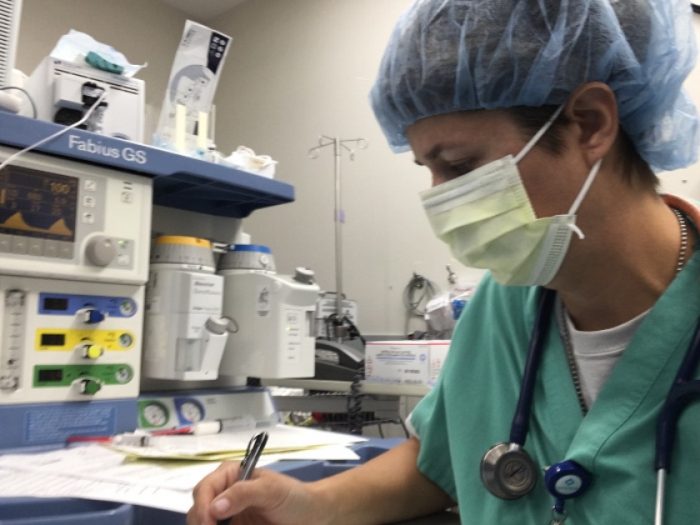Our brains are wired to be lazy.
Humans are mammals. As such, we create pattern generators.
What the hell are those?
A pattern generator is a neural pathway we create when we do something over and over. It’s how we learn to dance.
It’s how we learn to play basketball, ride a bike, or do our daily morning routine.
We do things over and over until we don’t have to think about the activity any more—it’s like we shift into autopilot. Autopilot can be good in some ways, but in terms of creativity—it’s no bueno.
I experience a lot of repetition in my career. I am a nurse anesthetist; I put people to sleep for a living. I also joke that I sit on a stool and pass gas all day. That’s how I roll.
I was falling asleep with my job—not literally, but figuratively. Work had become dull and unfulfilling.
Most of the cases are similar: I interview a patient prior to anesthetizing them, which involves the same several questions over and over. I’ve gotten to where I can rattle all of the body systems off without even blinking—cardiac, respiratory, gastrointestinal, and more.
“Have you had any troubles with your heart? High blood pressure, heart murmurs, heart attacks? Any shortness of breath when you walk around a ways? Any problems with your lungs like asthma, COPD, sleep apnea? Any heartburn or reflux, or any trouble with your liver or kidneys?” The list goes on.
I give my spiel about how I’m going to put them to sleep.
“For your anesthesia, we’re going to do a general anesthetic, meaning I’m going to use your IV to drift you completely off to sleep. Once you’re asleep and not aware of anything, I will put a little breathing tube in the back of your throat. This helps me make sure you’re breathing okay and also helps me to get those anesthetic gases to you that help you stay asleep.”
Blah, blah, blah.
When we enter the operating room, I start the process of anesthetizing someone. I go in the same order every time: oxygen, monitors, medications, tube, and then I start writing it all down.
I’ve done this so many times, I could do it in my sleep. I practically have on some call nights.
Patterns don’t happen just at work.
We’ve created a world around patterns—we have stores all over our country that are set up in roughly the same order so we don’t have to think about where to find our supplies and clothes.
We have restaurants in many cities where we can order the same chicken nuggets from the same menu anywhere from Orlando to Seattle. We can even buy the exact same underwear wherever we may roam.
We are so cliché.
Being such creatures of habit is really not our fault.
Biologically speaking, we are designed to create these pattern generators or neural pathways, which is kind of the fancy way of saying we are cutting a trail between two places we go frequently to make it easier on ourselves.
Think of it this way: instead of having to duck trees and dart between shrubs and forest undergrowth, we take loppers and saws and clear that path so every time we go to Grandma’s house, we don’t end up all scratched up, tired, and covered in itchy welts of poison ivy.
Once we start forming habits, it’s hard to shake them. It’s not that they’re completely useless; in fact, habits and patterns can have their benefits too.
Having routine can help me not forget steps when I’ve got someone’s life in my hands. That’s pretty important. Having repetitive procedure helps me when I’m called in in the middle of the night and I’m not in a state of 100 percent wakefulness.
Where habits become a hindrance, however, is how they limit our degree of creativity. They also interfere with us connecting with our lives by disengaging.
When we do the same thing over and over, it becomes automatic. It happens without thinking. I could drop a breathing tube in someone in my sleep.
These tasks are patterns, habits. The conscious effort is gone; instead a robot is, in essence, taking over.
So many times in life, we fall into these routines. We eat the same food, we go to the same three places in our little spheres. We get up, we go to work, we get home, we go to bed.
We exist on the same neural circuits; we are stuck on the path to Grandma’s.
Our brains tend to be lazy and follow that path of least resistance. I mean, who wants to chop more limbs out of the way?
However, it’s in chopping those new limbs out of the way that our brains expand, that our creativity flows, and that we live more in the moment. To engage more of our brain, we have to work it. We have to actively look for new paths and then clear them.
How do we do that?
We make our brains function better by doing things we haven’t done before. We break the pattern. Doing different activities and learning new things help to make new pathways in the brain and expand our overall function and creativity.
We can do this in many ways:
>> Eat at a new restaurant, or at least try a new dish at the old one: change up your routine, challenge new taste buds, and try combinations of flavor.
>> Learn a new language or boost your vocabulary.
>> Volunteer or connect with a culture you’re not accustomed to: learn new ways of handling what life throws you by seeing what other people do.
>> Shop at local and unique stores for your daily goods—avoid chains. Not only are you more likely to find different (and cooler) stuff, you also support local commerce and create a better community around you.
>> Go outside and get into nature, which provides us with tons of uniqueness and unboxed beauty. No two moments are exactly the same when you experience the natural world—it’s both soothing and inspirational. The stimulation you can get from all senses will blow any routine right out of your mind.
>> Write: I have been amazed at how many new thoughts and ideas have sprung up once I started writing for prompts given in the Elephant Academy—it’s like my brain has woken up! (Want to learn more?)
Sometimes we have to leave the routine in our lives, like with my job. Here are some things that helped me be more present and fulfilled when I’m at work:
>> I try to connect to people: instead of just talking, I listen more closely to what they have to say and try to express genuine concern for their questions or anxiety/fear.
>> I try to incorporate humor: when a patient is receptive, I try to make funny comments and ease the tension.
>> I try to put a little love and understanding in my work. It’s not always easy, but being actively involved in your life day-to-day makes it that much more meaningful and helps to give you purpose.
Since incorporating some of these practices into my home and work life, I no longer feel like I’m asleep at the wheel. I have awakened a new sense of engagement in my life.
~











Read 1 comment and reply